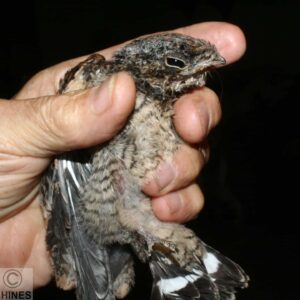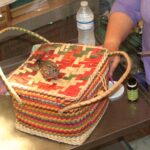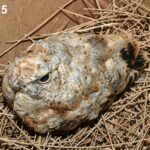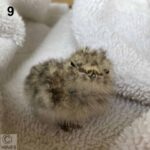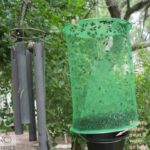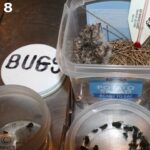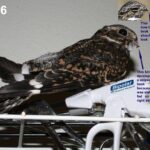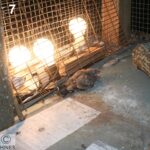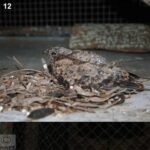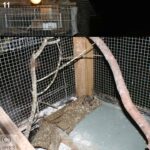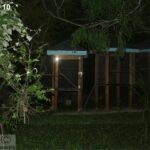A Wildlife Rehabilitators Guide To Raising Nightjars, Nighthawks And Whip-poor-wills
Ron Hines DVM PhD

Of all the birds that I raise for release, the solitary swallows called nightjars (nighthawks, whip-poor-wills and tropical pauraques) are my most challenging. Being ground nesters, the people who drop them off often assure me that they have brought me a baby screech owl that fell from its nest in some hollow tree or palm tree beard. Or perhaps a young hawk that fell from its nest. Few understand that these are birds that make no nest. They lay their two camouflaged eggs on the ground. Others come to me from elementary and middle school teachers. Their students find them near or in the school yards (jars often nest near the campus lights that help attract nighttime insects). Very little is known about the daily lives of North American nightjars. But year after year their close relatives, European nighthawks, for example tend to reside within 0.8 miles of their previous year’s nesting location once they have return from their winter quarters south of the Sahara). (ask me for Ng2018) Depending on the availability of flying insects, these birds can travel many miles from their roosting or nesting site to find concentrations of flying insects. (ask me for Evens2018) Our nightjars are probably quite similar.
Nightjars are particularly difficult for me to care for as injured adults or raise to maturity for release because, like all swallows, they are genetically programmed to feed while in flight – primarily at dusk and at dawn . Nothing is really known about the natural diets of American nightjars. It is just assumed that being swallows, they eat primarily flying insects and, being dusk/dawn feeders, those are most likely to be flying insects that are active at that time of day. So, there is a considerable amount of misinformation online and in print on what these birds eat in the wild and how they hunt. What we now known is that they attack flying prey from below using the contrast of the insect’s darker body highlighted against the back-lit sky during the blue hours. Unlike bats, they are visual hunters. Once the sky background is too dark, their prime feeding time is over until the blue hours of early morning. On well moonlit nights they may feed all night. Their average speed while feeding is about 19 mph. The bristly feathers on their chin are tactile and most likely assist in snatching prey out of the the air at just the right time. As you probably already know, nightjars can barely walk. Their wings are considerably longer than you might expect for a bird with so small a body size. So their ability to feed on ground insects is extremely limited. As chicks, nightjars rely on the regurgitated food of their parents. If that regurgitated food, like pigeon milk ,contains other added nutrients is unknown.
What we know about what nightjars are actually hunting for is changing too. As new DNA techniques become available that have the ability to identify the insect remains found in their droppings, we now know that the diet of European and Asian nighthawks consists of about 65% large moths. They will eat smaller moths, but they prefer the larger ones. You can see that their enormously wide mouths lend itself to that. Flies of various sorts comprise about 18% of their diet. Flying beetles made up about 10% of their diet. No evidence of crickets, meal worms, or darkling beetles (darkling beetles can’t fly) were found. (read here) In another European study, parent nightjars fed their babies a diet that was ~ 93% soft-bodied moths.
What Should I Feed Nightjars In Wildlife Rehabilitation Situations?
Pauraques range from the South Texas border all the way down to Argentina. On the wing or caught in a light, they have intensely red eyes. The particular pauraque chick in the photo above was brought to me as a pipping egg. A homeowner in a nearby town noticed two eggs on the ground near her doorstep. She picked them up and placed them under one of her broody bantam chickens. When one egg began to pip a few days later, she brought it to me. Very young nightjars and daytime swallows easily adapt to eating meal worms, small crickets, grubs and flies. In my case, the grubs, as well as earwigs, come from my compost pile. The flies come from my fly traps. Both as seen in the images below: I sun-bake the flies in a solar oven to sanitize them. (see here)
Perhaps because of its soft consistency (like a moth?) jars enjoy Friskies Purina Shreds as well. 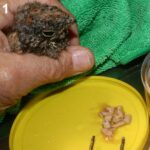
Force-Feeding
Older chicks and injured adults are considerably more challenging. They generally must be force-fed because it against their genetic instincts to feed while not in flight. A problem to avoid when doing so is scissor beak, a problem that occurs when you always force-feed a growing bird from the same side of its beak. You can see that problem in the nightjar pictured above. It was found in a school courtyard partially grown and raised on meal worms by one of the science teachers. By the time it was brought to me there was little I could do to assist it. The beak structure of rapidly growing birds is quite soft. It is easily traumatized when the beak is pried open. Since right-handed people generally hold the bird in their left hand and feed with their right hand, it is the right upper beak that eventually scars and grows slower than the left. That causes the upper beak to force a crossover bite. Some aviculture sources say that crossbeak can be permanently corrected by veterinarians and others. But the best one can realistically hope for is periodic beak trimming that stabilizes the problem (similar to corrective hoof trimming of foundered horses). When I tended to pet parrots and macaws, crossbeak was a rather common problem when breeders hand-fed large parrots and macaws from a syringe or spoon. To prevent the problem, alternating sides – even though it may not be as comfortable for you to do so – is essential. Once this problem occurs in wild birds they are unreleasable. Enlarge image 6.
How Can I Prepare Hand Raised Nightjars To Successfully Survive On Their Own After Release?
I feed immature nightjars at dusk. As they feather out, there will come a time when they obviously want out of their cage or enclosure. They will often vocalize and bounce against the top of their small enclosure attempting to escape. That is the time I move them outside into an electrically lit, outdoor enclosure. One similar to the ones seen in photo 7, 12, 11 & 10. I bring them back inside in the early morning and feed them. When the birds are capable of flying in circles in one of our rooms that is 18 x 18 foot with a 9 foot ceiling, the following evening I leave their outdoor cage door open and next morning they are gone.
At one point, in exasperation I established a cricket farm in a large vat with a screen lid and placed the growing nightjars in it overnight. I saw no evidence that they ever ate the crickets. I did the same thing with darkling beetles and their meal worms – with the same negative results. Finally, I built the illuminated plywood and window screen moth trap you see below and placed the nightjars in that overnight. The trap measures 18″ x 18″ x 36″ high. It is bulky and heavy, so I added lawn mower wheels.

Another Thing To Keep In Mind
Check the vents of these birds frequently. I have noticed that urates and feces tend to stick and accumulate around their vent that can, with time, lead to problems defecating. Gently clean that material off when required – even if a few small feathers come off with it.
How You Can Help
Email me and ask me to add your experience and thoughts about nightjars to this page.


